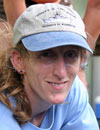|
|

 Today's Weather Blue Sky, Detached Clouds, Hazy Lat: 4° 35.41’N Long: 85° 41.76’W Wind: SSW Wind Speed: 11 to 16 Knots Sea State: 3 Swell Height: 4 to 6 feet Baro Press: 1008.8 MB Air Temp: 27.2°C 80.9°F Sea Temp: 28.6°C 83.4°F Vis: 8-10 nm  Anticipation Tim Shank can’t sit still. He races a half dozen times through the ship’s main lab to science meetings, huddles with the Alvin group in preparation for our first seafloor dive tomorrow, monitors the assembly of his biology equipment, and sends rapid-fire emails to colleagues in Massachusetts. Even as he types, his left leg bounces. Tomorrow morning, Tim and two others will dive to the bottom of the ocean, a journey three years in the making. “This is like the opening night of a play,” Tim said. “We know all our lines. We’ve done the dress rehearsals. Now we’ve got to perform.” As chief scientist of our expedition, Tim is leading 23 researchers to Rosebud, a hydrothermal vent field about half the size of a football field located 250 kilometers (220 nautical miles) northeast of the Galapagos Islands. Though everyone is excited to see what we’ll find, the journey holds special significance for Tim. He helped to discover Rosebud on May 26, 2002 during an Alvin dive 2,450 meters (8,100feet) below the sea surface. This is the first time anyone has been back in three years. “We went looking for an older vent field we have known about for many years, called Rose Garden,” he said. “But we discovered it had been wiped out by erupting lava from the seafloor.” However, just 250 meters (825 feet) from Rose Garden, scientists located and named Rosebud, a nod to the tiny tubeworms, clams, mussels, and anemones that had begun colonizing the young vent field.  Quicktime Movie » Windows Media Player » A middle school student in Carolyn Sheild's Lexington, Mass. class decorates a Styrofoam cup that we will shrink on the seafloor during tomorrow's dive in Alvin. In this video, the student explains her interest in deep-sea research. In the ship’s library this morning, Tim showed pictures of animals he saw that day. Black, shiny lava draped across the seafloor, evidence of a recent volcanic eruption at the field. “We could arrive tomorrow and see the whole thing wiped out by another eruption,” said Naomi Ward, a microbiologist on the 2002 expedition. “Or we could see amazing growth.” We have traveled for nearly 48 hours, steaming at 12 knots, to reach Rosebud from Costa Rica. During the journey, scientists have assembled research instruments, prepared their laptop computers for data entry, participated in three safety meetings, and shared with colleagues plans for upcoming chemical, biological, and geological research. “In two short days we’ve become a team,” said Tim. “Everyone is prepared. Now we’ve just got to get to the bottom of the ocean, and figure out our next step.” Read the new interview
Mail Buoy Do you have questions about oceanographic research, hydrothermal vents, or about what it is like to work on board a ship? E-mail your questions to the scientists working on board RV Atlantis at divediscover@atlantis.whoi.edu. Please tell us your town and state, and keep your messages short with no attachments. Read today's mail »
|
|||||||||||||||||||||||||||||||||||||||||||||||||||||||||||||||||||||||||||||||||||||||||||||
Mailing List | Feedback | Glossary | For Teachers | About Us | Contact
© 2010 Dive and Discover™. Dive and Discover™ is a registered trademark of
Woods
Hole Oceanographic Institution

 Stace Beaulieu, a state spelling bee champion turned scientist, once lost an eighth grade competition after tripping on the word “haddock.” “Can you believe I’m a marine biologist,” she said, “and I misspelled the name of a fish?” Today she says spelling, and a solid command of English, is helpful for successful biology research at WHOI. A big plus: “I rarely have to use spell check when I’m writing a paper.”
Stace Beaulieu, a state spelling bee champion turned scientist, once lost an eighth grade competition after tripping on the word “haddock.” “Can you believe I’m a marine biologist,” she said, “and I misspelled the name of a fish?” Today she says spelling, and a solid command of English, is helpful for successful biology research at WHOI. A big plus: “I rarely have to use spell check when I’m writing a paper.”